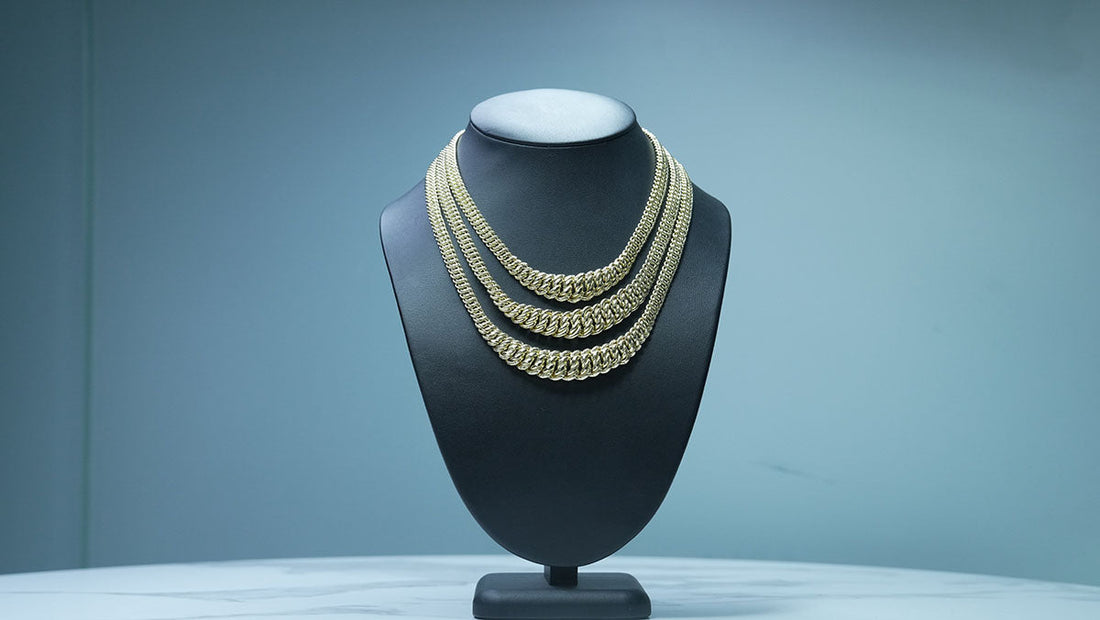
The Evolution of Gold Jewelry Designs Through Time
Share
Have you ever wondered why some jewelry feels timeless while others reflect the trends of the moment? Jewelry is far more than an accessory—it’s a mirror of history, culture, and the style of each era. Join us on a captivating journey through time to explore the evolution of gold jewelry design!
Ancient Egypt: The Gold of the Pharaohs
The ancient Egyptians revered gold as a symbol of divinity. Their jewelry, simple yet elegant, often featured scarabs, the Eye of Horus, or hieroglyphic motifs, embodying both artistry and meaning.
Classical Greece: Idealized Beauty
The Greeks, celebrated for their love of beauty and harmony, crafted delicate and sophisticated pieces. Necklaces adorned with pendants shaped like leaves, flowers, and animals were especially popular, reflecting both elegance and the natural world.

The Roman Empire: Power and Opulence
Romans had a passion for luxury and grandeur. Their jewelry, crafted from gold and precious stones, served as symbols of status and influence. Cameos and engraved gemstone rings were especially treasured, reflecting both wealth and sophistication.
The Middle Ages: Faith and Devotion
During the Middle Ages, jewelry was deeply influenced by religion. Crosses, depictions of the Virgin Mary, and other religious symbols were widespread. Long, delicate necklaces were particularly favored by noblewomen, combining elegance with spiritual significance.
The Renaissance: The Rebirth of Beauty
The Renaissance heralded a return to the classical ideals of beauty. Jewelry from this era was known for its intricate and detailed designs. Medallions and brooches became highly fashionable, showcasing artistry and refinement in every piece.

The Baroque Era: Exuberance and Movement
The Baroque period celebrated grandeur and dynamic expression. Jewelry from this era was bold, ornate, and rich in intricate details. Necklaces with large pendants and pieces adorned with vibrant gemstones were highly sought after, making a dramatic statement of elegance and opulence.
Art Nouveau: Nature as Inspiration
Art Nouveau, an artistic movement that flourished at the turn of the 20th century, drew inspiration from the flowing forms of nature. Jewelry from this era was delicate and feminine, featuring floral motifs, animals, and elegant curved lines—each piece a harmonious blend of art and wearable beauty.

Art Deco: Geometry and Glamour
Emerging in the 1920s, Art Deco jewelry was defined by clean lines, geometric shapes, and modern materials. These pieces exuded elegance and sophistication, often featuring bold geometric designs paired with contrasting colored gemstones—a true reflection of the era’s glamour and refinement.
Modern and Contemporary Jewelry: Freedom of Expression
Today, jewelry knows no boundaries. Designers experiment freely with diverse materials and innovative techniques, creating unique, one-of-a-kind pieces that express individuality and creativity. Modern jewelry is as much about personal storytelling as it is about beauty.

Jewelry: A Legacy That Lasts
Throughout history, jewelry has been far more than mere adornment. It has served as a symbol of status, a reflection of culture, and a means of expressing individuality. At Ventura Jewelry, we draw inspiration from this rich heritage to craft unique, timeless pieces that will accompany you throughout your life.
The next time you consider selecting that perfect gold piece, trust Ventura Jewelry for all your authentic jewelry needs. Reach out to us for more information and let us help you find a piece that becomes part of your story.
